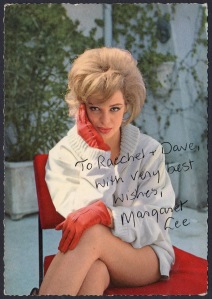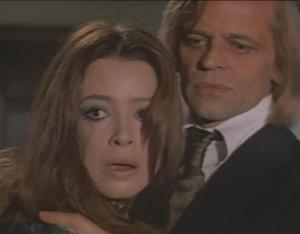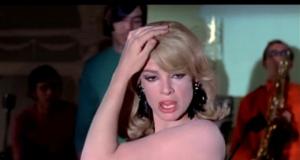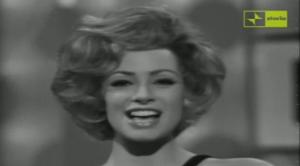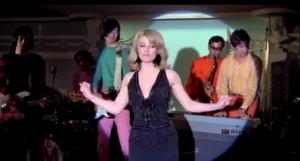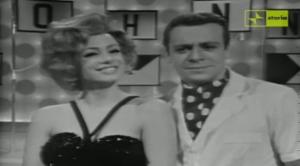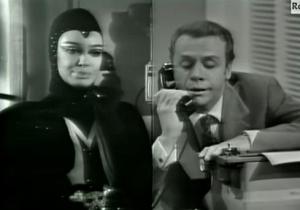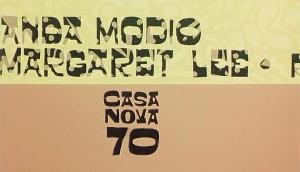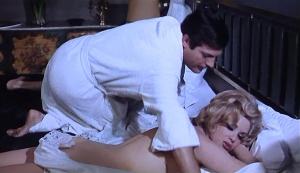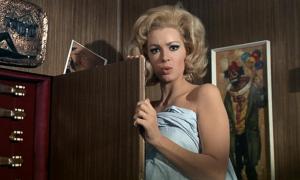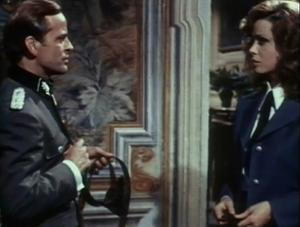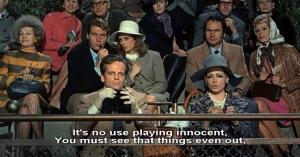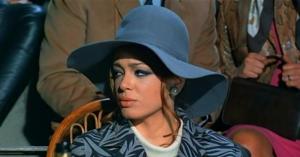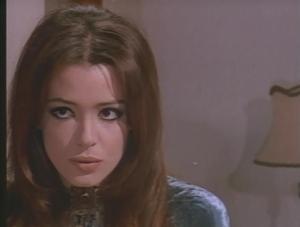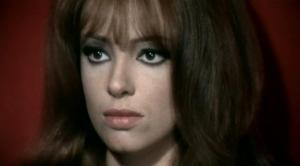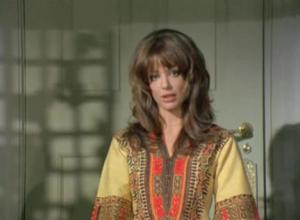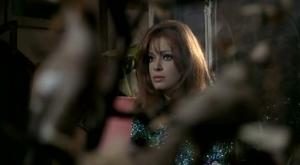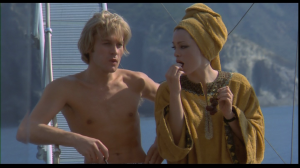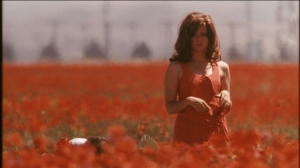The Naughty Cheerleader aka Mir hat es immer Spaß gemacht; How Did a Nice Girl Like You Get Into This Business?; Wie kommt ein so reizendes Mädchen zu diesem Gewerbe? (Dir Will Tremper, 1970)
Basic plot: Sixteen year old Lynn Keefe dumps her dull but reliable boyfriend Ronnie for the more exciting Nick. But when she tells Nick that he’s got her pregnant he doesn’t want to know her anymore. She leaves town, moving from one adventure to the next and from one man to the next. Things go from bad to worse until she meets Gino, but what will happen when Gino finds out about her past?
Cast: Juan José Ignatio Rodriguez de Calderon / ‘Sam’ – Klaus Kinski; Lynn Keefe – Barbi Benton; Gino – Hampton Fancher; Frank – Roman Murray; B.J. Hankins – Broderick Crawford; The Admiral – Lionel Stander; Nick – Clyde Ventura; Bob Greene – Jeff Cooper; Hugh Hefner – Hugh Hefner; Bellhop – Ed Begley Jr.
Filming location: Rome, Italy; USA; Germany
Release date: 15 January 1970 (West Germany)
Availability: This doesn’t seem to be officially available anywhere but you can get it on DVD-R and there are probably old VHS copies knocking around if you’re hard pushed to find a copy. My DVD was from Mod Cinema – it only runs at 85 minutes (the US version is supposed to be 87 minutes) and the quality is not fantastic; still, beggars can’t be choosers. If/when it becomes available officially I’ll take another look at it, particularly if it’s the German release (the 105 minutes version).

The film – *SPOILER ALERT*:
This film is totally throwaway and nonsense, but that’s nothing new. This seems to be a recurring comment with my reviews: how did a great actor like Klaus Kinski get into this picture? And, by the way, you’ll be waiting at least an hour before you even see KK, so settle in a long and bumpy ride if you decide to watch this one.

The film begins somewhere near the end of the story. Lynn Keefe (played by the very cute Barbi Benton) is lounging around in a swimming pool and overhears an Italian nobleman arguing with his wife.



When he appears by the poolside she speaks with him, asking if he is really a Duke. He is, so she promises him a surprise that she can guarantee “won’t be an unpleasant shock.” It doesn’t take much imagination to guess what she is referring to, but then we have to go back to the beginning of her story to find out how this “nice girl” got into this business.

Lynn comes from Scranton, Pennsylvania and as a 16 year old schoolgirl she’s dating a guy called Ronnie – as she describes him, “the type of boy a girl likes to take home – he had everything a girl could ask for. Except sex appeal…” She dreams of being with an older guy called Nick, who is the exact opposite of Ronnie – “frightening and fascinating at the same time” – but doesn’t realise that the exciting Nick is not the loving kind. Her opportunity to get with Nick presents itself at his party, when she abandons Ronnie to go off on a motorbike ride with Nick.
For a film starring a Playboy model you’d expect to see Barbi Benton’s clothes fall off, if only a little bit, but it’s interesting that the most sexually objective imagery in the film is of Nick. Here’s how we see Nick portrayed:


In case you want to put a face to the crotch, here’s Nick:

Bad boy Nick wants to take Lynn for more than a bike ride; he unbuckles his pants whilst still driving and takes Lynn’s virginity on the back of his bike on the eve of her 16th birthday. The next day Lynn’s mum and dad announce that they have got her a bicycle for her birthday, “so you can go riding with Ronnie”. Lynn busts out crying, out of guilt, as she’s been “riding” with Nick all night…
Lynn breaks off with Ronnie as she foolishly thinks that if she plays it cool, Nick might ask her to marry him. The signs don’t look good though as there is no talk of love or marriage from Nick – just lots of sex. And the lots of sex eventually leads to pregnancy, which doesn’t go down too well with the footloose and fancy free Nick. He tells Lynn that she’s a dumb kid and that she should pin the pregnancy on someone else instead; he thinks she has been with loads of guys and clearly doesn’t realise that he was in fact the only one. In some kind of acknowledgement that the situation with Nick is hopeless, Lynn tells him that she hopes he dies or breaks his neck. Then she runs away, claiming that she won’t go back to Scranton again until she has found a nice husband.
With the bad boy Nick experience behind her and a baby on the way, you’d think that Lynn would realise that you need to get to know men before declaring love for them and expecting marriage, but from here on in she moves from man to man hoping that they will love and marry her.
She starts working at a hotel in the Catskills as a waitress and soon realises that “all the staff [are] in and out of the sack with each other.” One after one, the men at the hotel try it on with Lynn.
First there’s the lusty character who asks her out for a drink, but gets caught out as her colleague overhears and says he’s tried it on with her too:

The Maitre d’ tries it on with her in a rowing boat, forcing her to jump in the water to escape his attentions:

The married hotel hairdresser who has a custom built bed in his car to invite women back:

And then there’s the busboy, and the bellhop Timmy:

And the good looking state trooper who wants to arrest her when he discovers she’s run away from home:

Lynn manages to escape the state troopers’ clutches without arrest, but now she has turned 17 and her baby belly is beginning to show. She worries about the baby having no father and decides that she should find a willing “university guy with brains.” She proposes to do this by hanging around the campus reading a book about sex.

Um…not sure how that would work, but we don’t get to find out anyway as unfortunately (or possibly fortunately, who knows) Lynn loses the baby and doesn’t need a father for it anymore.
But Lynn lives in Lynn world and even in hospital, having just miscarried her child, she falls in love with her doctor, Clint, who she says is the only person she would willingly kill.

Why? Because she felt he was her dream come true and thought he felt the same way as her but unfortunately she was mistaken on this point; he’s happily married and was only being nice to her as he was scared she might do something silly after losing the baby.

She leaves the clinic hating Dr Clint and heads off to find a job in Philadelphia. Failing to find work, she considers a position modelling for a fashion show. But it all begins to look a bit dodgy when she meets the Smirna Brothers, two old guys, and they tell her to show her bosoms. She seems outraged and turns down their offers of $10 and then $20. The older brother (played by the film director Max Nosseck) tells the younger brother (played by Bruce Low, who appeared in a few RW Fassbinder films): “Let her go, Jeff. Stupid bitch!”


The “stupid bitch” flees, but it’s out of the frying pan and into the fire really. She heads off for Boston with less than $5 in her pocket. A guy she calls the Admiral sits next to her on the bus. He’s played by Lionel Stander:

To scare him away Lynn tells him she’s a prostitute but it’s her day off; instead of frightening the old guy, he asks her price. She tells him she charges $100, thinking he couldn’t afford it, but this backfires when he gives her the money. She closes her eyes and thinks of the money and, as she puts it, bangs him there on the bus to Boston. She blanks the dirty deed out of her memory and just thinks of how the money will keep her going for 3 weeks.
Having taken her first steps towards prostitution, Lynn carries on in that general direction. She gets a job as an elevator girl but on her first day at the company she ends up going over to guy’s house. The man is question is Frank Blake:

He’s no looker but somehow Lynn falls in love with him almost immediately. Frank wants her to help him with some business and in return he will make her a partner in his record company. He wants Lynn to seduce “the heaviest DJ in this town”, Bob Greene, who can make or break careers in the music industry; when he pushes a record, it’s a hit. It seems that Frank and his partner Ward Collins had made Bob an offer that he was opposed to on moral grounds, and as this didn’t work they intend to resort to blackmail to convince him into helping their acts get into the charts. They need Lynn to help them out and despite the fact that she has just met Frank, who states that his main interest in life is money, and that what he proposes is downright immoral, Lynn says she will do it but that she is only doing it for Frank and not the contract or the money. Sucker!

Lynn tries her best to ensnare Bob but after much effort, she seems to be getting nowhere with him. Whatever she does she cannot seem to get the response Frank requires from Bob and so she tells Frank that they can be happy without a million dollars. Frank really does not look convinced on this point and he insists that Lynn continue with her efforts to get Bob into the back seat of his gold caddy. Eventually her persistence pays off and Frank gets the evidence he needs to be able to convince Bob Greene to promote his acts. The photo of Bob with underage Lynn is all it takes for Bob to mention Frank’s act and their record 6 times on his TV show in the space of 5 days.

Success follows along with a four-way partnership between Frank, Ward, Lynn and Bob. Lynn lives and works with Frank for a few months, and during this time turns 18. But once again, it dawns on Lynn that the man she’s with has not spoken to her of love or marriage; all he ever talks about is business and money.
So it’s not exactly surprising when Frank tries to get Lynn out of his home and love life by telling her that he won’t get married until he has made his first million and, furthermore, he thinks she can be replaced in the business with an $85 a week secretary as she does so little for her 25% share in the record company; this despite Lynn’s involvement in getting Bob Greene on board in the first place. But as Ward Collins puts it so well, “Business is business, there’s nothing personal involved here, dear.”
Perhaps Lynn takes this on board as she tells them to shove it, takes their pay-off cheque and leaves for Miami Beach hoping to keep up her standard of living, come what may – even if that involves “business” because, in her own words, her “dreams of a superman are a thing of the past.” How Frank could ever be described as a superman is beyond the stretch of even my very overactive imagination…

Lynn has only just arrived at Miami Beach when she is mistaken for Miss Luxembourg. Lynn is about to set the record straight when she is spotted by Juan José Ignatio Rodriguez de Calderon, who for some unknown reason goes under the name of Sam. Yes, the moment we have all been waiting for, the appearance of KK!
And is it worth waiting for? You bet! Klaus looks fabulous wearing a white hat and carrying a Malacca cane:


He’s a high-class pimp who can see an opportunity to exploit Lynn and so tips the bellhop to “get the chick’s room number.” He heads off to Lynn’s room and sneaks in:




It’s kind of even worthwhile watching this film just to see Klaus looking so good.



With one hand over Lynn’s mouth and a cut-throat razor in the other, Sam puts his proposal to Lynn.




He rolls out credit cards for her to inspect and tells her: “You’re just a delicious girl and I want to make a deal with you.” I can’t understand what he says after that, he seems to be stuttering and mumbling and, quite frankly, the dialogue is no good anyway and the acting is terrible; even Klaus’ in this instance.


I’m still not convinced that Klaus could play for laughs and this film seems to confirm it. Unless, of course, he was just trying to blend in with the other “actors” in the film – if not, he looks like an inexperienced actor over-acting. And he’s supposed to be Cuban but he is just speaking in his German accent. Not exactly convincing, but I don’t even want to think about it.
Anyway, the gist of the proposition is that the Miss Universe competition is taking place and Sam wants to pimp Lynn out as Miss Luxembourg to any dirty old man who will pay a minimum of $1,000 to spend some time with her. He books Lynn into a penthouse suite and tells her to leave the rest to him. Before long he’s sending the dirty old men over and collecting the fees. Lynn doesn’t seem to mind too much as although they’re all lousy lovers, none of them stay very long.
The first client wants Lynn to be Lady Godiva, whilst he’s the horse:


The second, an Argentinian multi-millionaire, almost dies in her arms. He pays an extra $500 for photos with her, for “the memories”:


The third client has a $3,000 bet on the baseball and wants to watch the match in bed with her, wearing his sock suspenders, his shoes and some hideous patterned undercrackers. His man boobs hang down.

Lynn looks bored and gives him some popcorn. He loses his bet and then Sam, who just hangs around in his kaftan, leaning in the doorway, smoking, tells the old guy his time is up:

Then there’s Billy Joe and his bossy dad, BJ Hankins who buys some time with Miss Luxembourg for his son:

Billy Joe is very shy, he’s 20 and a virgin; he says he doesn’t know what he needs to do. But he clearly enjoyed himself a lot and walking down the hotel corridor with his dad, he says he hopes Miss Luxembourg wins the competition. BJ is just wondering what he can do to make sure she wins when at the opposite end of the corridor they see an old guy exiting another room, also carrying a Miss Luxembourg sash…
What’s going off? Well, greedy Sam had set up another girl further down the corridor and was also pimping her out as Miss Luxembourg. A recipe for disaster, so Sam and Lynn take the next flight to Europe before the scandal erupts.

But Sam already has plans for Lynn; spotting Hugh Hefner on the flight, he pushes Lynn onto the gangway next to Hefner, which is a cheeky reference to the fact that Barbi Benton was Hefner’s real-life girlfriend back then. So when they arrive in Rome, Lynn finds herself on the cover of the papers with Hefner and Sam decides to cash in on her new-found fame by touting her out as a “starlet”. He tells her she just needs to unbutton her top a little and then all the film producers will want to have her; seemed to work for her with this film, that’s all I’m saying…

Lynn then embarks on a tour of Rome, taking in as many men as Sam throws her way. First up is Sam’s friend, Olivetti, “the typewriter guy”. Sam tells Lynn that Olivetti will put her in a film, so she sleeps with him, and then he introduces her to a fat guy who he says is a director.

But what is Klaus up to? Black and white shirt with ruffled cuffs – check. Bug eye glasses – check. Open shirt – check. Hairy chest out – check. He’s got it all. He looks like a human fly. And he’s being cheeky with Barbi Benton; he flicks her hair out of the way and starts undoing the front zipper on her dress. Tut, tut!





The “director” asks if Lynn will undress, and whilst Sam nods enthusiastically, I wouldn’t be too hopeful, boys, because you only ever get to see her in various states of undress and she never actually does undress in front of the film camera; you’ll have to buy the Playboy magazines if you want to see anything more. Although she has that thing about the tongue that Ornella Muti has (see Love and Money a story in photos for more details), I’m not quite sure if this is supposed to be sexy or not?







Well, Lynn does “undress” for the director in that she gets into a bubbly hot-tub with him – he babbles on in Italian, gets undressed, covers himself only with something that I imagine is supposed to be a giant sponge, but which looks more like a giant loaf of bread. However big it is, it’s not big enough to hide his flabby bits.

I’m pretty sure Lynn’s thinking the same thing as she shrieks when he begins to chase her around the hot tub. The “director” doesn’t seem to be a director after all – what a surprise!
Because of this, things between Sam and Lynn are not going so well and we next see Sam dressed in a sea captain’s outfit, aboard a boat with Lynn and yet another guy.

Sam looks like he is going to throw up, then he falls out of his chair and goes overboard. Just in time, apparently, as Lynn discovers that the guy who owns the boat also thinks he owns her, at least for a while, as he’s paid Sam 500,000 lire.


Lynn didn’t know anything about Sam’s deal and thought she was going to be in a film, but it seems this guy just wants to go to Capri and have some fun. So Sam’s taken the money and ran off – wading ashore in his sailor’s outfit, waving his umbrella in Lynn’s direction.








Lynn is fuming now and is letting Sam know this by throwing magazines and books at him as he tries to dodge them – hard work when you’re wearing yet another kaftan; this one’s red. Lynn tells Sam he’s a pimp; as if he didn’t know. And then things get worse when she discovers that he has lost all their money ($20,000) on a “sure winner” called Lightning Bolt.



In the nick of time, the door knocks and in walks a real film producer. But now Lynn won’t believe Sam and she’s acting up, much to Sam’s dismay, until it suddenly dawns on her that this guy is the real deal. The next thing you know she’s on a film set and being asked to undress. “Undress? Never! Either I play this part with my clothes on or nothing happens.”


So Lynn doesn’t get her film career – but instead she gets her “one true love”; Gino. Yes, Gino follows her off-set and says: “What is a charming girl like you doing in a place like this?” And although Lynn said she wouldn’t fall in love again, she does.

But Sam stands between Lynn and her happiness as he threatens to tell Gino about her unless she gets $50,000 from Gino for him. Lynn is surprised that Sam thinks Gino would have that much money as she knows him as a poor struggling man; Sam tells her that Gino is the son of a multi-millionaire from Milan.

As Lynn is then seen to be marrying Gino you do wonder if she’s marrying him for his wealth, but it soon becomes apparent that that’s not the reason when Sam demands his $50k and Lynn tells him that Gino has been disinherited by his father for marrying her; in fact, they’ve put the wedding on Sam’s bill! Sam is last seen sneaking out of the building when he realises he’s going to be left with a large bill to settle.


Talking of large bills, Gino starts as he means to go on by honeymooning with Lynn in Monte Carlo and losing £20k of borrowed money on roulette. This leaves them with no funds – they’re having to thumb rides now and they can’t pay their hotel bills.
But Gino says he can get some money, so he goes out and leaves Lynn alone all day. And now we’re back up to date as Lynn is in bed with the Italian nobleman we saw her talking to at the opening of the film. She’s telling him that marriage is a sacred thing for Gino, which is funny when she’s in bed with someone else; the Duke tells her that her story needs a happy ending, so she helpfully tells him where he left his cheque book.

How can marriage with Gino work under these circumstances? Well, Gino is downstairs with the Duke’s wife, doing the same as Lynn, but it seems he’s not as experienced as she is in such matters because he only accepts the Duchess’ cheque “reluctantly”. So when Gino climbs in through window and catches Lynn in bed with the Duke, he’s not devastated; they just realise that they’re a perfect match and the film has its happy ending after all.
— 0 —
What a load of twaddle! But at least it doesn’t pretend to be anything other than it is. And there is the one shot of Klaus with both hands in his pockets:

What with that and the amazing outfits he wears in this film, I’d say The Naughty Cheerleader is worth a look.




 Hanussen, Dir O W Fischer and Georg Marischka (1955). I’ve not yet got or seen this film but Klaus looks quite lovely in the pictures in this film programme so it’s on my list of wants.
Hanussen, Dir O W Fischer and Georg Marischka (1955). I’ve not yet got or seen this film but Klaus looks quite lovely in the pictures in this film programme so it’s on my list of wants.






 Der Rächer, dir Karl Anton (1960). No pictures of Klaus here, I’m afraid, but plenty of stills from the film and lots of information. Again, this is a film I don’t yet have. I had hoped to find loads of these Film Bühne movie programmes in Berlin and although I saw quite a lot they were mostly for classical Hollywood cinema, which was both a surprise and a disappointment really. Never mind, there is always next time.
Der Rächer, dir Karl Anton (1960). No pictures of Klaus here, I’m afraid, but plenty of stills from the film and lots of information. Again, this is a film I don’t yet have. I had hoped to find loads of these Film Bühne movie programmes in Berlin and although I saw quite a lot they were mostly for classical Hollywood cinema, which was both a surprise and a disappointment really. Never mind, there is always next time. I’m not sure what this photo is from – Jack the Ripper? Lifespan? I dunno. Hopefully one of the Kinski superfans will tell me!
I’m not sure what this photo is from – Jack the Ripper? Lifespan? I dunno. Hopefully one of the Kinski superfans will tell me! I also managed to find a copy of the Ich, Kinski book at an art book shop as well – this is possibly my favourite find of the trip. I might have to do a post on Kinski books at some point so I can say more about that.
I also managed to find a copy of the Ich, Kinski book at an art book shop as well – this is possibly my favourite find of the trip. I might have to do a post on Kinski books at some point so I can say more about that. I found this great (but no doubt unofficial) Klaus Kinski t-shirt on one of the flea markets as well. Looks very much like a Beat Presser Paris photo to me but I doubt very much Beat will be seeing any money from this purchase somehow!
I found this great (but no doubt unofficial) Klaus Kinski t-shirt on one of the flea markets as well. Looks very much like a Beat Presser Paris photo to me but I doubt very much Beat will be seeing any money from this purchase somehow!
